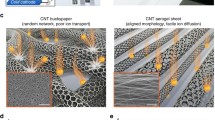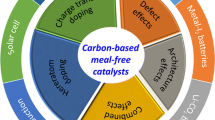Abstract
To decrease the consumption of fossil fuels, research has been done on utilizing low grade heat, sourced from industrial waste streams. One promising thermoenergy conversion system is a thermogalvanic cell; it consists of two identical electrodes held at different temperatures that are placed in contact with a redox-based electrolyte [1, 2]. The temperature dependence of the direction of redox reactions allows power to be extracted from the cell [3, 4]. This study aims to increase the power conversion efficiency and reduce the cost of thermogalvanic cells by optimizing the electrolyte and utilizing a carbon based electromaterial, reduced graphene oxide, as electrodes. Thermal conductivity measurements of the K3Fe(CN)6/K4Fe(CN)6 solutions used, indicate that the thermal conductivity decreases from 0.591 to 0.547 W/m K as the concentration is increased from 0.1 to 0.4 M. The lower thermal conductivity allowed a larger temperature gradient to be maintained in the cell. Increasing the electrolyte concentration also resulted in higher power densities, brought about by a decrease in the ohmic overpotential of the cell, which allowed higher values of short circuit current to be generated. The concentration of 0.4 M K3Fe(CN)6/K4Fe(CN)6 is optimal for thermal harvesting applications using R-GO electrodes due to the synergistic effect of the reduction in thermal flux across the cell and the enhancement of power output, on the overall power conversion efficiency. The maximum mass power density obtained using R-GO electrodes was 25.51 W/kg (three orders of magnitude higher than platinum) at a temperature difference of 60 °C and a K3Fe(CN)6/K4Fe(CN)6 concentration of 0.4 M.










Similar content being viewed by others
References
Quickenden TI, Mua Y. The power conversion efficiencies of a thermogalvanic cell operated in three different orientations. J Electrochem Soc. 1995;142(11):3652–9.
Ratkje SK, Ikeshoji T, Syverud K. Heat and internal energy changes at electrodes and junctions in thermocells. J Electrochem Soc. 1990;137(7):2088–95.
Quickenden TI, Mua Y. A review of power generation in aqueous thermogalvanic cells. J Electrochem Soc. 1995;142(11):3985–94.
Goncalves R, Ikeshoji T. Comparative studies of a thermoelectric converter by a thermogalvanic cell with a mixture of concentrated potassium ferrocyanide and potassium ferricyanide aqueous solutions at great temperature differences. J Braz Chem Soc. 1992;3(3):4.
Noam L. Energy resources and use: the present (2008) situation and possible sustainable paths to the future. Energy. 2010;35(6):2631–8.
Fronk BM, Neal R, Garimella S. Evolution of the transition to a world driven by renewable energy. J Energy Res Technol. 2010;132(2):21009–15.
Vining CB. An inconvenient truth about thermoelectrics. Nat Mater. 2009;8(2):83–5.
Hertz HG, Ratkje SK. Theory of thermocells. J Electrochem Soc. 1989;136(6):1698–704.
Hornut JM, Storck A. Experimental and theoretical analysis of a thermogalvanic undivided flow cell with two aqueous electrolytes at different temperatures. J Appl Electrochem. 1991;21(12):1103–13.
Mua Y, Quickenden TI. Power conversion efficiency, electrode separation, and overpotential in the ferricyanide/ferrocyanide thermogalvanic cell. J Electrochem Soc. 1996;143(8):2558–64.
Li D, et al. Processable aqueous dispersions of graphene nanosheets. Nat Nano. 2008;3(2):101–5.
Khan U, et al. High-concentration solvent exfoliation of graphene. Small. 2010;6(7):864–71.
Lee C, et al. Measurement of the elastic properties and intrinsic strength of monolayer graphene. Science. 2008;321(5887):385–8.
Wang N, et al. The investigation of thermal conductivity and energy storage properties of graphite/paraffin composites. J Therm. Anal. Calorim. 2012;107:949–54.
Bolotin KI, et al. Ultrahigh electron mobility in suspended graphene. Solid State Commun. 2008;146(9–10):351–5.
Stoller MD, et al. Graphene-based ultracapacitors. Nano Lett. 2008;8(10):3498–502.
Eizenberg M, Blakely JM. Carbon monolayer phase condensation on Ni(111). Surf Sci. 1979;82(1):228–36.
Novoselov KS, et al. Electric field effect in atomically thin carbon films. Science. 2004;306(5696):666–9.
Coleman JN. Liquid-phase exfoliation of nanotubes and graphene. Adv Funct Mater. 2009;19(23):3680–95.
Park S, et al. Colloidal suspensions of highly reduced graphene oxide in a wide variety of organic solvents. Nano Lett. 2009;9(4):1593–7.
C-Therm Technologies Ltd.C-Therm Technologies-Products. http://www.ctherm.com/products/tci_thermal_conductivity.
Lerf A, et al. Structure of graphite oxide revisited. J Phys Chem B. 1998;102(23):4477–82.
Stankovich S, et al. Synthesis of graphene-based nanosheets via chemical reduction of exfoliated graphite oxide. Carbon. 2007;45(7):1558–65.
da Silva M, et al. Synthesis and characterization of CeO2–graphene composite. J Therm Anal Calorim. 2012;107(1):257–63.
Hu R, et al. Harvesting waste thermal energy using a carbon-nanotube-based thermo-electrochemical cell. Nano Lett. 2010;10(3):838–46.
Artjom VS. Theoretical study of thermogalvanic cells in steady state. Electrochim Acta. 1994;39(4):597–609.
Quickenden TI, Vernon CF. Thermogalvanic conversion of heat to electricity. Sol Energy. 1986;36(1):63–72.
Atkins P, Paula Jd. Physical chemistry. New York: Oxford University Press; 2002.
Acknowledgements
The authors gratefully acknowledge funding from C-THERM TECHNOLOGIES for presentation of this work, the Department of Science and Technology, Philippines, and the ARC Centre of Excellence for Electromaterials Science.
Author information
Authors and Affiliations
Corresponding author
Rights and permissions
About this article
Cite this article
Romano, M.S., Gambhir, S., Razal, J.M. et al. Novel carbon materials for thermal energy harvesting. J Therm Anal Calorim 109, 1229–1235 (2012). https://doi.org/10.1007/s10973-012-2311-9
Published:
Issue Date:
DOI: https://doi.org/10.1007/s10973-012-2311-9




